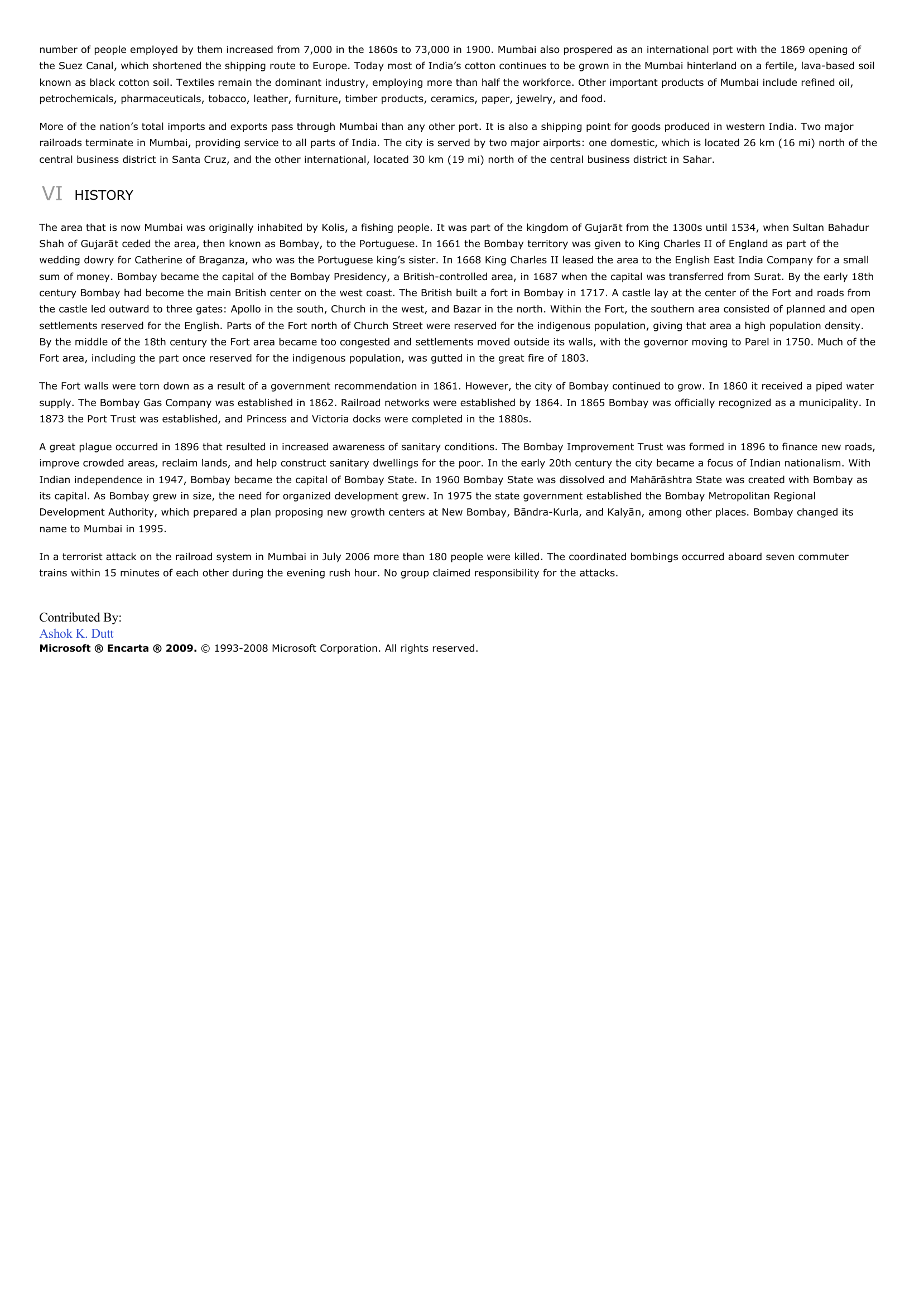Mumbai - geography.
Publié le 04/05/2013

Extrait du document
«
number of people employed by them increased from 7,000 in the 1860s to 73,000 in 1900.
Mumbai also prospered as an international port with the 1869 opening ofthe Suez Canal, which shortened the shipping route to Europe.
Today most of India’s cotton continues to be grown in the Mumbai hinterland on a fertile, lava-based soilknown as black cotton soil.
Textiles remain the dominant industry, employing more than half the workforce.
Other important products of Mumbai include refined oil,petrochemicals, pharmaceuticals, tobacco, leather, furniture, timber products, ceramics, paper, jewelry, and food.
More of the nation’s total imports and exports pass through Mumbai than any other port.
It is also a shipping point for goods produced in western India.
Two majorrailroads terminate in Mumbai, providing service to all parts of India.
The city is served by two major airports: one domestic, which is located 26 km (16 mi) north of thecentral business district in Santa Cruz, and the other international, located 30 km (19 mi) north of the central business district in Sahar.
VI HISTORY
The area that is now Mumbai was originally inhabited by Kolis, a fishing people.
It was part of the kingdom of Gujarāt from the 1300s until 1534, when Sultan BahadurShah of Gujar āt ceded the area, then known as Bombay, to the Portuguese.
In 1661 the Bombay territory was given to King Charles II of England as part of thewedding dowry for Catherine of Braganza, who was the Portuguese king’s sister.
In 1668 King Charles II leased the area to the English East India Company for a smallsum of money.
Bombay became the capital of the Bombay Presidency, a British-controlled area, in 1687 when the capital was transferred from Surat.
By the early 18thcentury Bombay had become the main British center on the west coast.
The British built a fort in Bombay in 1717.
A castle lay at the center of the Fort and roads fromthe castle led outward to three gates: Apollo in the south, Church in the west, and Bazar in the north.
Within the Fort, the southern area consisted of planned and opensettlements reserved for the English.
Parts of the Fort north of Church Street were reserved for the indigenous population, giving that area a high population density.By the middle of the 18th century the Fort area became too congested and settlements moved outside its walls, with the governor moving to Parel in 1750.
Much of theFort area, including the part once reserved for the indigenous population, was gutted in the great fire of 1803.
The Fort walls were torn down as a result of a government recommendation in 1861.
However, the city of Bombay continued to grow.
In 1860 it received a piped watersupply.
The Bombay Gas Company was established in 1862.
Railroad networks were established by 1864.
In 1865 Bombay was officially recognized as a municipality.
In1873 the Port Trust was established, and Princess and Victoria docks were completed in the 1880s.
A great plague occurred in 1896 that resulted in increased awareness of sanitary conditions.
The Bombay Improvement Trust was formed in 1896 to finance new roads,improve crowded areas, reclaim lands, and help construct sanitary dwellings for the poor.
In the early 20th century the city became a focus of Indian nationalism.
WithIndian independence in 1947, Bombay became the capital of Bombay State.
In 1960 Bombay State was dissolved and Mah ārā shtra State was created with Bombay asits capital.
As Bombay grew in size, the need for organized development grew.
In 1975 the state government established the Bombay Metropolitan RegionalDevelopment Authority, which prepared a plan proposing new growth centers at New Bombay, B āndra-Kurla, and Kaly ān, among other places.
Bombay changed itsname to Mumbai in 1995.
In a terrorist attack on the railroad system in Mumbai in July 2006 more than 180 people were killed.
The coordinated bombings occurred aboard seven commutertrains within 15 minutes of each other during the evening rush hour.
No group claimed responsibility for the attacks.
Contributed By:Ashok K.
DuttMicrosoft ® Encarta ® 2009. © 1993-2008 Microsoft Corporation.
All rights reserved..
»
↓↓↓ APERÇU DU DOCUMENT ↓↓↓
Liens utiles
- Mumbai - geography.
- Mumbai
- Mumbai - geographie.
- Mumbai, auparavant Bombay est une grande ville de l'état Indien
- Tokyo - geography.

































